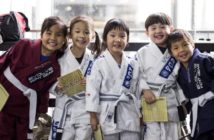Martial arts across the world assume that an energy known as Ki, Qi, or many similar names flows through the body and that proper breathing techniques can regulate the flow of this energy. Regardless of the true nature of Ki, studies show that the breathing techniques in many martial arts, such as Aikido and Shaolin Kung Fu, do have effects that reduce stress and fatigue in the body. The distribution of oxygen changes when using these techniques, healing the human body.
Deep Breathing Is The Common Connector
The one commonality between martial art breathing styles is an emphasis on diaphragm breathing or deep breathing. In diaphragm breathing, martial artists are taught to take slower, longer breaths. These longer breaths have muted sound to rapid, shallow breathing, and allow oxygen to distribute to more receptors in the lungs. This calm approach to breathing is present in nearly all recreational or self-defense martial arts, regardless of their origin.
Breathing Methods Are Still Being Refined
The Nishino Breathing Method (NBM) is a technique developed by Kozo Nishino, a practitioner of Japanese Aikido. Aikido is a modern Japanese martial art utilizing throws and holds, which emphasizes manipulating the flow of force and calm approaches to outside aggression. Nishino took the basic breathing techniques of Aikido and later refined them by combining them with American ballerina techniques to teach his own method of breathing control in the United States.
Steps In Kung Fu
Several of the focuses of breathing exercises are shared with Shaolin Kung Fu, and other martial arts though. Breathing exercises throughout the various martial arts have different names, but many common steps. Learning to breathe through the nose less is important since it can’t absorb enough oxygen during intense exertion. They also emphasis exhaling deeply after a long breath, to manipulate the literal and metaphorical pressure you feel in your chest.
And most martial arts consider that everyone breathes slightly differently. Shaolin Kung Fu has a step called Attentive Breathing. It’s important to note that, even when slowing down and performing deep breathing, everyone’s form of relaxed breathing is different. Tai Chi takes this a step further by suggestion you take a while to reach your relaxed breathing state if necessary because many people come into the gym stressed out and need time to calm down.
Breathe In, Breathe Out
Martial arts make use of many common steps during breathing exercises. They utilize deep breathing and urge students to inhale deeply and exhale slowly without relying too heavily on the nose. These steps and others are commonplace in martial arts like Japanese Aikido and Chinese Kung Fu, and many of them even synthesize new breathing techniques to form newer, modern approaches. The NBM, for example, combines simple ballerina training with Aikido for maximum effect.





2 Comments
dissertations online dissertation
Excellent read, love anything about motorcycles!!!